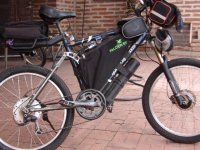arthurtuxedo
100 W
So I've pretty much decided on a Cute Q100H as the motor for my upcoming build, and reading what people have to say, it seems like it can take a lot of power for such a light motor. My question is: how much?
I have seen recommendations that the older Q100 should be run at no more than 18A, and most people seem to settle around 800W as the max power for a Q100H, but who has actually found the motor's limit the hard way?
My hunch is that I can run it at 52V and 25A and it will handle that just fine, but I'm prepared to be corrected. If I don't get a solid answer, they are cheap enough that I might just buy 2 and use the first one to answer my own question. If so, I'll be sure to tell you all about it!
I have seen recommendations that the older Q100 should be run at no more than 18A, and most people seem to settle around 800W as the max power for a Q100H, but who has actually found the motor's limit the hard way?
My hunch is that I can run it at 52V and 25A and it will handle that just fine, but I'm prepared to be corrected. If I don't get a solid answer, they are cheap enough that I might just buy 2 and use the first one to answer my own question. If so, I'll be sure to tell you all about it!


